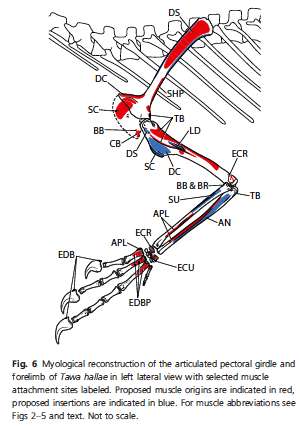Complete forelimb myology of the basal theropod dinosaur Tawa hallae based on a novel robust muscle reconstruction method
Author:
Burch
Abstract:
The forelimbs of nonavian theropod dinosaurs have been the subject of considerable study and speculation due to their varied morphology and role in the evolution of flight. Although many studies on the functional morphology of a limb require an understanding of its musculature, comparatively little is known about the forelimb myology of theropods and other bipedal dinosaurs. Previous phylogenetically based myological reconstructions have been limited to the shoulder, restricting their utility in analyses of whole-limb function. The antebrachial and manual musculature in particular have remained largely unstudied due to uncertain muscular homologies in archosaurs. Through analysis of the musculature of extant taxa in a robust statistical framework, this study presents new hypotheses of homology for the distal limb musculature of archosaurs and provides the first complete reconstruction of dinosaurian forelimb musculature, including the antebrachial and intrinsic manual muscles. Data on the forelimb myology of a broad sample of extant birds, crocodylians, lizards, and turtles were analyzed using maximum likelihood ancestral state reconstruction and examined together with the osteology of the early theropod Tawa hallae from the Late Triassic of New Mexico to formulate a complete plesiomorphic myology for the theropod forelimb. Comparisons with previous reconstructions show that the shoulder musculature of basal theropods is more similar to that of basal ornithischians and sauropodomorphs than to that of dromaeosaurids. Greater development of the supracoracoideus and deltoideus musculature in theropods over other bipedal dinosaurs correlates with stronger movements of the forelimb at the shoulder and an emphasis on apprehension of relatively large prey. This emphasis is further supported by the morphology of the antebrachium and the intrinsic manual musculature, which exhibit a high degree of excursion and a robust morphology well-suited for powerful digital flexion. The forelimb myology of Tawa established here helps infer the ancestral conformation of the forelimb musculature and the osteological correlates of major muscle groups in early theropods. These data are critical for investigations addressing questions relating to the evolution of specialized forelimb function across Theropoda.
Wednesday, July 16, 2014
The Arms of Tawa hallae, a Theropod Dinosaur From Norian Triassic New Mexico
Labels:
dinosaurs,
fossils,
New Mexico,
nonavian dinosaurs,
norian,
paleontology,
theropods,
Triassic
Subscribe to:
Post Comments (Atom)


No comments:
Post a Comment